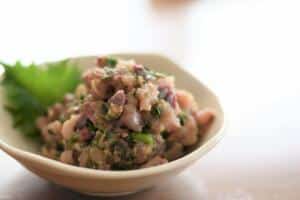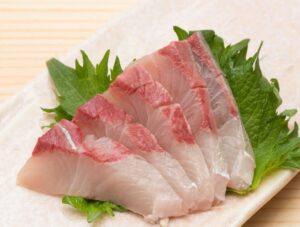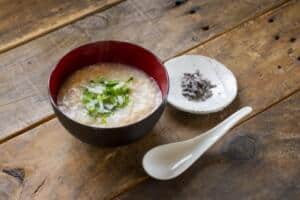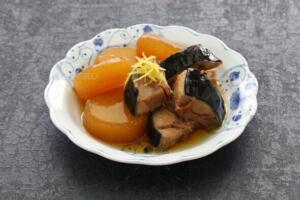Aji (鯵), known as horse mackerel in Japan, is a staple in Japanese cuisine beloved for its mild flavor and versatility. Whether grilled, fried, or served as fresh sashimi, Aji offers a delicious experience in every bite. This article explores the different ways people prepare and enjoy aji across Japan, highlighting why it remains a favorite in both home kitchens and restaurants. Dive in to discover the rich traditions and tasty recipes that make Aji a must-try for anyone interested in authentic Japanese food.
What is Aji?

In Japan, “Aji” (鯵) is the name for horse mackerel, a popular fish in Japanese cooking. Aji has a mild flavor and offers great versatility, allowing cooks to prepare it in various ways. You can enjoy it grilled, fried, or raw as sashimi. The name “horse mackerel” reflects its tasty qualities, and people love its delicious flavor whether they eat it fresh, grilled with salt, or fried.
History

Horse mackerel has been a part of the Japanese diet since ancient times, with its history going back as far as the Jomon period. People often processed aji into dried fish that lasted a long time, and they even presented it to the Imperial Court, which is far from the sea. It wasn’t until the Edo period when it started appearing on the tables of ordinary people, but it has continued to be a staple of the Japanese diet for several hundred years since then.
Types of Aji

In Japan, there are three main types of horse mackerel: Japanese horse mackerel, brown horse mackerel, and striped horse mackerel.
- Japanese horse mackerel is the most common and is found from Hokkaido to Kyushu. It is small, about 30 cm long, with translucent, pale flesh that’s great for sashimi or nigiri sushi. However, it spoils quickly, so it should be eaten very fresh if served raw.
- Muroaji is another type found mainly in Kyushu. It’s larger, about 40 to 50 cm long, with darker flesh due to its high blood content. Because it spoils quickly, it’s not widely available and is mostly eaten locally.
- Shimaaji, or striped horse mackerel, is less common and has distinctive yellow stripes. Chefs and diners prize Shimaaji for its clear, beautiful flesh and delicate flavor, which explains why high-end restaurants often feature it. Connoisseurs especially value larger specimens of Shimaaji.
Horse Mackerel: A Staple of Japanese Cuisine
In Japan, horse mackerel is used in a variety of dishes. Here are some of the most popular:
Aji no Tataki
This dish features fresh horse mackerel finely chopped and mixed with aromatic green onions and refreshing ginger. Simple yet flavorful, it highlights the freshness of the fish and is loved by many.
Grilled Aji with Salt
By sprinkling salt on horse mackerel and grilling it, the natural flavors of the fish can be fully enjoyed. The crispy exterior and tender interior create a simple yet profound taste that enhances your appetite.
Aji Fry
Chefs carefully bread and fry horse mackerel to achieve a crispy texture, which perfectly complements the fish’s juicy flavor. Often served with tartar sauce, this hearty dish is a favorite on family tables.
Aji Nanban-zuke
Fried horse mackerel is marinated in sweet vinegar and served with onions and carrots. The perfect balance of sourness and sweetness offers a refreshing aftertaste, making it a cherished dish, especially in hot seasons.
Aji no Namero
Horse mackerel is mixed with miso and pounded into a rich and flavorful side dish for sake. This dish showcases the freshness of the fish while highlighting the umami of miso, making it a perfect match with Japanese sake or shochu.

These dishes utilize the unique qualities of horse mackerel, offering a wide range of flavors and cooking methods. Horse mackerel dishes add color to Japanese dining tables and truly reflect the charm of Japanese culinary culture.
FAQ
- When is the season for horse mackerel?
People consider aji to be in season from spring to fall, but markets often offer it throughout the year.
- What are the characteristics of fresh horse mackerel?
The red color characterizes the gills of the horse mackerel. Gills that turn yellow to brown often indicate the fish is not fresh.
Aji Recipe
Ingredients of Aji nare-roe
| Ingredients for 2 persons | Measurements |
|---|---|
| Horse mackerel (cut into 3 pieces for sashimi) | 200g |
| Long onion | 40g |
| Perilla leaves | 15g |
| [A] Miso | 10g |
| [A] Mirin | 10g |
| [A] Ground sesame | 10g |
| [A] Ginger (grated) | 5g |
How to make Aji nare-roe?
Remove the skin from the horse mackerel, pound it with a knife, and roughly chop it. Finely chop the green onion and cut the shiso leaves into thin strips.
Place the ingredients on a cutting board, add all condiments (A), and mix while beating with a knife.
Recommended Restaurants
Uoteru (魚輝)

Uoteru is a popular seafood restaurant located near Roppongi Midtown. In this relaxing space, you can enjoy dishes such as the “Sashimimori” (a sashimi platter) made with high-quality fresh fish selected by the owner. And the “Seasonal Fried Horse Mackerel and Red Eggplant”. The menu includes exquisite dishes carefully crafted for both taste and appearance.
Summary

In Japan, people love aji, or horse mackerel, for its mild flavor and versatility. Whether they enjoy it as sashimi, grilled, or fried, aji serves as a staple in Japanese cuisine, appreciated for its fresh taste and simple preparation.
You can check some Japanese seafood dishes that we know you would like to try too.
















Comments